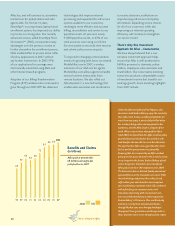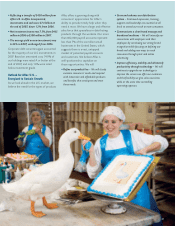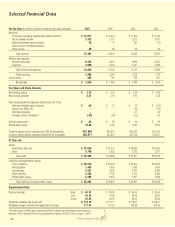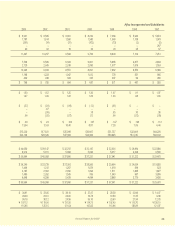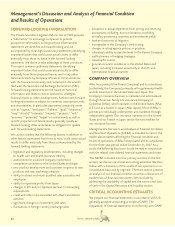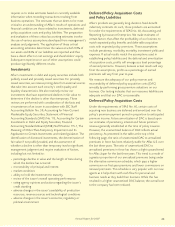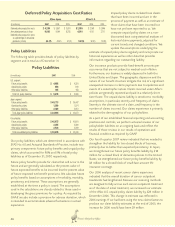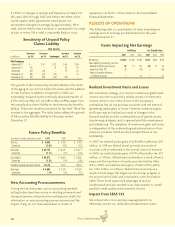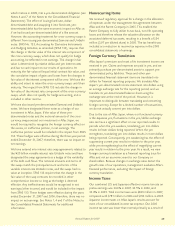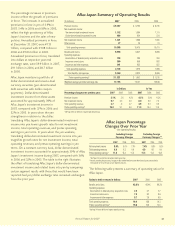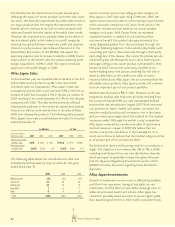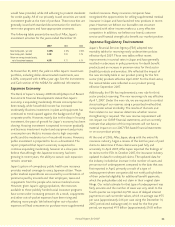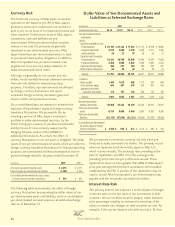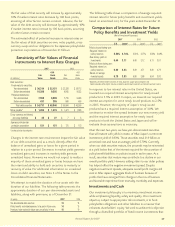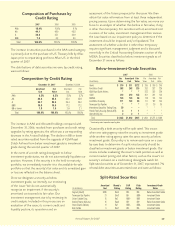Aflac 2007 Annual Report Download - page 33
Download and view the complete annual report
Please find page 33 of the 2007 Aflac annual report below. You can navigate through the pages in the report by either clicking on the pages listed below, or by using the keyword search tool below to find specific information within the annual report.
29
Annual Report for 2007
which mature in 2009, into a yen-denominated obligation (see
Notes 4 and 7 of the Notes to the Consolidated Financial
Statements). The effect of issuing fixed-rate, dollar-
denominated debt and swapping it into fixed-rate, yen-
denominated debt has the same economic impact on Aflac as
if we had issued yen-denominated debt of a like amount.
However, the accounting treatment for cross-currency swaps is
different from issuing yen-denominated Samurai and Uridashi
notes. SFAS No. 133, Accounting for Derivative Instruments
and Hedging Activities, as amended (SFAS 133), requires that
the change in the fair value of the interest rate component of
the cross-currency swaps, which does not qualify for hedge
accounting, be reflected in net earnings. This change in fair
value is determined by relative dollar and yen interest rates
and has no cash impact on our results of operations. At
maturity, the fair value will equal initial contract fair value, and
the cumulative impact of gains and losses from the changes in
fair value of the interest component will be zero. We have the
ability and intent to retain the cross-currency swaps until their
maturity. The impact from SFAS 133 includes the change in
fair value of the interest rate component of the cross-currency
swaps, which does not qualify for hedge accounting, and is
included in other income.
We have also issued yen-denominated Samurai and Uridashi
notes. We have designated these notes as a hedge of our
investment in Aflac Japan. If the value of these yen-
denominated notes and the notional amounts of the cross-
currency swaps exceed our investment in Aflac Japan, we
would be required to recognize the foreign currency effect on
the excess, or ineffective portion, in net earnings. The
ineffective portion would be included in the impact from SFAS
133. These hedges were effective during the three-year period
ended December 31, 2007; therefore, there was no impact on
net earnings.
We have entered into interest rate swap agreements related to
the ¥20 billion variable interest rate Uridashi notes and have
designated the swap agreements as a hedge of the variability
of the debt cash flows. The notional amounts and terms of
the swaps match the principal amount and terms of the
variable interest rate Uridashi notes, and the swaps had no
value at inception. SFAS 133 requires that the change in the
fair value of the swap contracts be recorded in other
comprehensive income so long as the hedge is deemed
effective. Any ineffectiveness would be recognized in net
earnings (other income) and would be included in the impact
from SFAS 133. These hedges were effective during the years
ended December 31, 2007 and 2006; therefore, there was no
impact on net earnings. See Notes 1, 4 and 7 of the Notes to
the Consolidated Financial Statements for additional
information.
Nonrecurring Items
We received regulatory approval for a change in the allocation
of expenses under the management fee agreement between
Aflac and the Parent Company in 2005. This enabled the
Parent Company to fully utilize its tax-basis, non-life operating
losses and therefore release the valuation allowance on the
associated deferred tax assets, resulting in a benefit of $34
million ($.07 per diluted share) in 2005. The tax benefit was
included as a reduction to income tax expense in the 2005
consolidated statements of earnings.
Foreign Currency Translation
Aflac Japan’s premiums and most of its investment income are
received in yen. Claims and expenses are paid in yen, and we
primarily purchase yen-denominated assets to support yen-
denominated policy liabilities. These and other yen-
denominated financial statement items are translated into
dollars for financial reporting purposes. We translate Aflac
Japan’s yen-denominated income statement into dollars using
an average exchange rate for the reporting period, and we
translate its yen-denominated balance sheet using the
exchange rate at the end of the period. However, it is
important to distinguish between translating and converting
foreign currency. Except for a limited number of transactions,
we do not actually convert yen into dollars.
Due to the size of Aflac Japan, where our functional currency
is the Japanese yen, fluctuations in the yen/dollar exchange
rate can have a significant effect on our reported results. In
periods when the yen weakens, translating yen into dollars
results in fewer dollars being reported. When the yen
strengthens, translating yen into dollars results in more dollars
being reported. Consequently, yen weakening has the effect of
suppressing current year results in relation to the prior year,
while yen strengthening has the effect of magnifying current
year results in relation to the prior year. As a result, we view
foreign currency translation as a financial reporting issue for
Aflac and not an economic event to our Company or
shareholders. Because changes in exchange rates distort the
growth rates of our operations, management evaluates Aflac’s
financial performance, excluding the impact of foreign
currency translation.
Income Taxes
Our combined U.S. and Japanese effective income tax rate on
pretax earnings was 34.6% in 2007, 34.5% in 2006, and
33.4% in 2005. Total income taxes were $865 million in 2007,
compared with $781 million in 2006 and $743 million in 2005.
Japanese income taxes on Aflac Japan’s results account for
most of our consolidated income tax expense. Our 2005
income tax rate was lower than normal primarily as a result of



